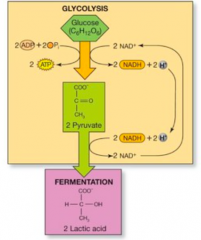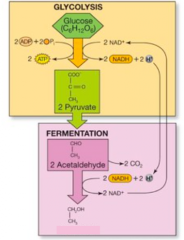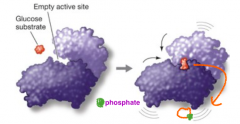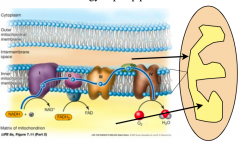![]()
![]()
![]()
Use LEFT and RIGHT arrow keys to navigate between flashcards;
Use UP and DOWN arrow keys to flip the card;
H to show hint;
A reads text to speech;
17 Cards in this Set
- Front
- Back
|
Discribe the process of anaerobic respiration in animal . |

- glycolysis, produced 2 pyruvate, 2CO2, 2ATP - entering fermentation and produce 2 lactic acid -free the NADH to NAD+ so that glycolysis can continue |
|
|
Describe the process of anaerobic respiration in plants. |

- glycolysis produced 2pyruvate, 2CO2, 2ATP - entering fermentation and produce 2 ethanol - free NADH to NAD+ so that glycolysis can continue |
|

what is the purple molecule and what does it produce ? |
- it is hexokinase - it is an enzyme, that carries out phosphorylation of glucose (sugar) - hexokinase - glucose-6-phosphate - phosphorylation is part of glycolysis |
|

identify the process and describe it. |
- electron-transport chain - the last step in aerobic respiration - NADH is oxidised back to NAD+ at NADH dehydrogenase protein complex - FADH2 is oxidised back to FAD at cytochrome electron carrier protein complex - and electrons are released - and passed down the transmembrane proteins as current - electrons are then taken up by O2 and hydrogen ion as they form water - also hydrogen ions are being pumped through protein channels from matrix into inter membrane space to create concentration gradient - at ATP synthase, hydrogen ions goes form inter membrane space out to matrix - as it happens ADP is converted into ATP - ATP produced is then transported out of the mitochondria through protein channel. |
|
|
why is the total energy (ATP) produce a range (36-38ATP) ? |
- In eukaryotes, 2ATP is required to transport 2NADH across membrane into mitochondria |
|
|
Which part of aerobic respiration produce the most ATP molecule per mole of glucose ? |
- oxidation phosphorylation = ETC + Citric acid cycle |
|
|
List the 3 types of transmembrane proteins in electron-transport chain. |
- NADH dehydrogenation protein complex - cytochrome electron carrier protein complex - ATP synthase protein complex |
|
|
How many ATP molecules and other products are produced at citric acid cycle? |
- 1 ATP per pyruvate - 2 CO2 per pyruvate - intotal, 2 ATP and 4 CO2 are produced - Also 6 NADH & 2 FADH2 produced |
|
|
General equation of respiration ? |
C6H12O6 + 6O2 --> 6 CO2 + 6H2O + 36-38 ATP |
|
|
Briefly describe the sequence of aerobic respiration. |
Glycolysis -->pyruvate oxidation --> citric acid cycle --> electron transport chain |
|
|
What is produced after pyruvate oxidation ? |
- 2Acetyl coA and 2CO2 & 2NADH |
|
|
What is the product straight after glycolysis ? |
- 2ATP , 2NADH, 2 pyruvate |
|
|
Why does a cell need energy ? list 4 cellular process. |
- Active transport - cell division - protein synthesis - photosynthesis |
|
|
ATP is a carrier of energy. What type of molecule is ATP ? How is the energy held in the molecule ? |
- ATP is a nucleotide (an adenosine + 3 phosphate group + sugar ) - energy is released by hydrolysis of the 3rd phosphate group and ADP is formed .(particularly in the P-O bonds between phosphate groups) - This allow ADP molecule to absorb energy and regain the group. - Hence, it allows ATP to store energy like a rechargeable battery |
|
|
In eukaryotic cells, where is most of the ATP produced that is used in general cellular processes ? |
- In mitochondria - around 36-38 ATP |
|
|
Glucose is a 6-carbon molecule. How many carbons are there in each molecules of pyruvate and the acetyl group of acetyl-coA? what happened to the lost carbons ? |
- 3 carbons in each pyruvate - 2 carbons are lost as 2 CO2 - for each acetyl-coA there are 2 carbons |
|
|
Describe briefly the mechanism of citric acid cycle. |
- Acetyl-coA (2 carbons atom)is too short to undergo further reaction.Thus, it combines with oxaloacetic acid (has 4 carbons atom) to form citric acid (6 carbon) - The missing 2 carbon (lose 1 carbon per pyruvate) formed carbon dioxide giving up electrons to enable NAD+ +2electrons + H+ -->NADH |

